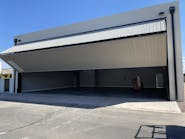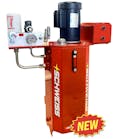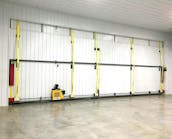Tips for Navigating Hangar and Leasehold Acquisitions
The record-setting demand for business aircraft has been widely reported. The demand continues to exceed the aircraft available on the market; many of the purchasers are first-time aircraft buyers. Along with the demand for business aircraft comes the demand for hangar space to store the aircraft. Increased costs in raw materials, labor, and inevitable delays make construction of a new aircraft hangar impractical for many aircraft owners. This combination has many new aircraft owners looking to purchase an existing hangar instead.
Katrin Gist, chairperson of CBRE’s Aviation Properties, who represents clients nationwide in the purchase, sale and leasing of airport properties, offered this advice to aircraft owners in search of space to store their aircraft, “If you can find something [an existing hangar] to buy, you should because new construction is so expensive.” Gist and I share the common bond of having worked with clients nationwide to secure hangar space and understand the most common impediments to smooth closings.
Acquiring hangar space at an airport is very different from other commercial real estate transactions. This is largely because airports tend to be federally obligated and the owner of the airport, commonly referred to as the Airport Sponsor, is required to abide by Federal Grant Assurances. Those Federal Grant Assurances dictate terms that the Airport Sponsor is required to adhere to in its operation of the airport and also terms that must be included in all leases of airport premises.
Often, first-time hangar buyers are surprised by the complexity of the transaction. As with any transaction, surprises may create delays and unexpected expenses. The purpose of this article is to educate first-time buyers so that the delays and expenses are managed and do not derail the transaction. Most hangar acquisitions start with a letter of intent and are followed by a purchase and sale agreement. The top five things that a hangar buyer should consider whether they are entering into a letter of intent or a purchase and sale agreement are (1) understand what you are buying; (2) what does the process for acquiring the hangar entail; (3) what due diligence will you need; (4) are you able to use the hangar for the purposes you intend to; and (5) will you need to make improvements to the hangar and are you able to make those improvements.
Understand What You Are Buying
At most airports, the hangar can’t be bought fee simple. This is because often hangars on airports are constructed through public-private partnerships. Like FBOs, a commercial party such as a hangar developer constructs the hangar in exchange for a long-term ground lease. Such ground lease terms are often more than 20-30 years; allowing the original developer/ground lessee to amortize the expense of construction. The ground lease generally requires that the hangar and any other improvements constructed on the premises revert to the Airport Sponsor at the conclusion of the term. Therefore, what is being purchased is the remaining interest in the hangar until it reverts to the Airport Sponsor and an assignment of the long-term ground lease.
In other cases, notes Doug Wilson, president of FBO Partners, an advisory service to both FBOs and private equity, adds that the prospective hangar “may actually be on an apportioned portion of larger leasehold, such as a ground sublease.” In such cases, the ground lease, ground sublease and any HOA-style rules or shared expense matters should be considered, adds Wilson. As a threshold matter, any prospective purchaser should verify that the leasehold interest is assignable. Gist adds that “the value of the hangar is largely dependent on the term remaining on the ground lease.” Thus, the longer the lease term remaining — and assuming a high demand airport — the higher the value of the hangar. Hangar purchasers often assume that they will be able to get an extension from the airport. This is not always the case and varies significantly from airport to airport and depends on the demand for space at the airport as well as public contracting laws within the jurisdiction. Gist advises that she counsels prospective purchasers that if a longer ground lease term is critical to the deal value than an extension should be secured prior to closing, however, she also advises that at many airports this is not generally practical within the closing time frame and/or something that the Airport Sponsor is willing to do. Thus, if an extended lease term is a critical deal point, a prospective buyer should consider adding it as a contingency to the acquisition.
Understand the Process for Acquiring the Interest
Assuming that the prospective purchaser understands what they are buying and has verified that the long-term lease is assignable, they must next consider what the process for the assignment of the lease is. Most airport leases will require approval of Airport Sponsor before they can be assigned. The process for approving assignments of airport leases varies significantly from airport to airport. Gist notes that the more in demand the airport is the more complicated and lengthier the process for approving lease assignments is.
Most commonly, the Airport Sponsor is a municipality or quasi-government authority. As a result, the approval of an assignment may require it to be acted upon at a public meeting of a City Council or Airport Commission and may require an opportunity for community/public comment before action. If this is the case, it is important to understand the frequency that the City Council/Airport Commission meets, amount of notice required for agendas, and the process for getting a matter on the agenda. It is not usual for such meetings to occur on a monthly basis and require that items being presented appear on an agenda published a week in advance. In addition, the prospective buyer should inquire as to what will be required before the assignment can be presented for approval. In most cases, the City Council or Airport Commission will require a fully executed purchase and sale agreement before it will consider the approval of the assignment. At some airports, the Airport Manager/Director has the authority to consent to the assignment of an airport lease. Nonetheless, it is still important to note what the Airport Manager/Director will need to review in order to consent to the assignment and what the timeline for such approvals is.
Based on the foregoing, it is important that your letter of intent and purchase and sale agreement account for a closing date consistent with the process for approval of the assignment. In short, you don’t want to be bound to a closing date prior to when you reasonable anticipate the Airport Sponsor to approve the assignment of the lease.
Consider What Due Diligence Is Needed
The level of due diligence that a prospective purchaser will seek is generally related to the purchase price and the length of the lease and whether the purchase is being financed. Generally, the greater the investment the more due diligence a prospective purchaser will seek. In setting terms for the letter of intent and/or purchase and sale agreement, prospective buyers should not only consider what due diligence they may want but also what their lender may require.
Due diligence may include the following: (1) review of the underlying ground lease and related documents; (2) inspection of the premises by a structural engineer; and (3) environmental inspections. A prospective purchaser may want to have a structural engineer evaluate the premises and confirm that they are structurally sound. Additionally, if the prospective purchaser is going to be assuming liability for the condition of the premises, they may want to have a Phase I environmental inspection conducted. It comes as no surprise that PFAS and fuel contamination are often identified on airports. It is common for letters of intent to include thirty (30) days for due diligence. It is good practice to include provisions that allow for the due diligence period to be extended for good cause.
As part of the Due Diligence, Gist recommends that prospective purchasers consider whether their airplane(s) will fit in the hangar and if there is the slightest question to seek the opportunity for a test fit. Whether a prospective buyer is going to have any inspections or simply do a test fit, the buyer should be prepared to demonstrate that it has sufficient insurance to cover any damage to persons or property that occur during the due diligence and further agree to defend, indemnify and hold the seller and the airport harmless for any damage to persons or property that occur as a result of the prospective buyer’s due diligence.
Consider Whether You Are Able To Use the Hangar for the Purpose You Are Seeking
Many first-time hangar purchasers may not appreciate the fact that there may be limitations on what the hangar can be used for. A prospective purchaser should expect that their use of the hangar will be limited to aviation purposes. There may be other limitations and those limitations may be scattered throughout the lease, the Airport’s Minimum Standards, any Airport Rules and Regulations as well as the Airport’s Master Plan, and Airport Layout Plan. This is particularly important if the prospective user intends to use the hangar for a commercial purpose. Often, a buyer may not fully realize their intended purpose is in fact, commercial. There are often very specific requirements that airports impose on entities seeking to engage in commercial operations on airport premises. “If part of the financial model of hangar acquisition presupposes offsetting costs by renting out the additional space, that’s a commercial activity in the eyes of an airport.” cautions Wilson. Therefore, a prospective buyer should seek out the Minimum Standards, Airport Rules and Regulations, the Airport Master Plan and Airport Layout Plan and confirm that their intended use of the premises is consistent with the requirements of those documents.
Consider Whether You Are Able To Make Needed Improvements.
A prospective buyer should evaluate what if any improvements it intends to make to the premises. Additional improvements and/or expansion of the hangar will likely require approval of the Airport Sponsor. Therefore, it is important to understand what the approval process requires and the timeline for that process. A prospective buyer may also want to consider whether the Airport Sponsor’s history of approving tenant improvement plans is. Are they generally approved or does the Airport Sponsor weigh in on the plans. Gist cautions prospective buyers to “Be thinking about more than what you need now. Leave room for growth. Plan for growth. Hangars are not easy to come by.”
Paying attention to the points raised herein, which often surprise prospective hangar buyers, are important to effectuating a smooth transaction. Additionally, prospective buyers should not underestimate the importance of working with qualified professionals who are experienced in these types of transactions. Prospective buyers should seek out the advice of real estate professionals who engage in aircraft hangar sales and also seek advice from attorneys experienced in buying and selling aircraft hangars on airports. Their experience and knowledge in this area will save you delay and expense that is avoidable by working with experienced professionals. In closing, I thank Katrin Gist and Doug Wilson for their collaboration in this article.
Alison L. Squiccimarro is an attorney with the Law Offices of Paul A. Lange, LLC with offices in New York and Connecticut. Squiccimarro's nationwide practice focuses on aviation related commercial litigation with an emphasis on FAA and DOT regulatory issues, airports, insurance coverage and employment matters.




